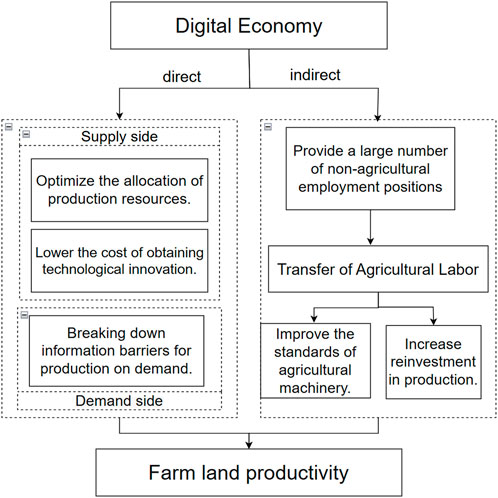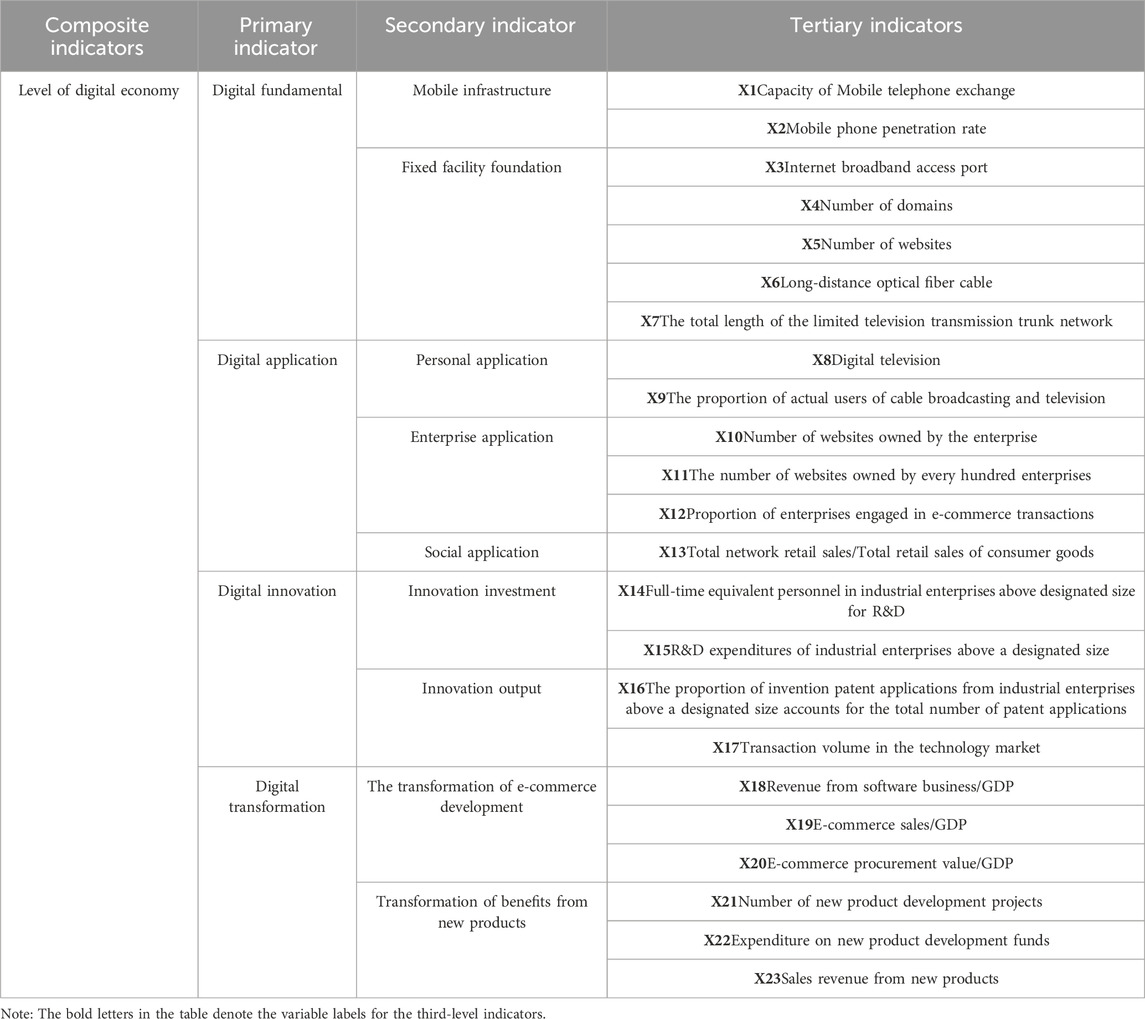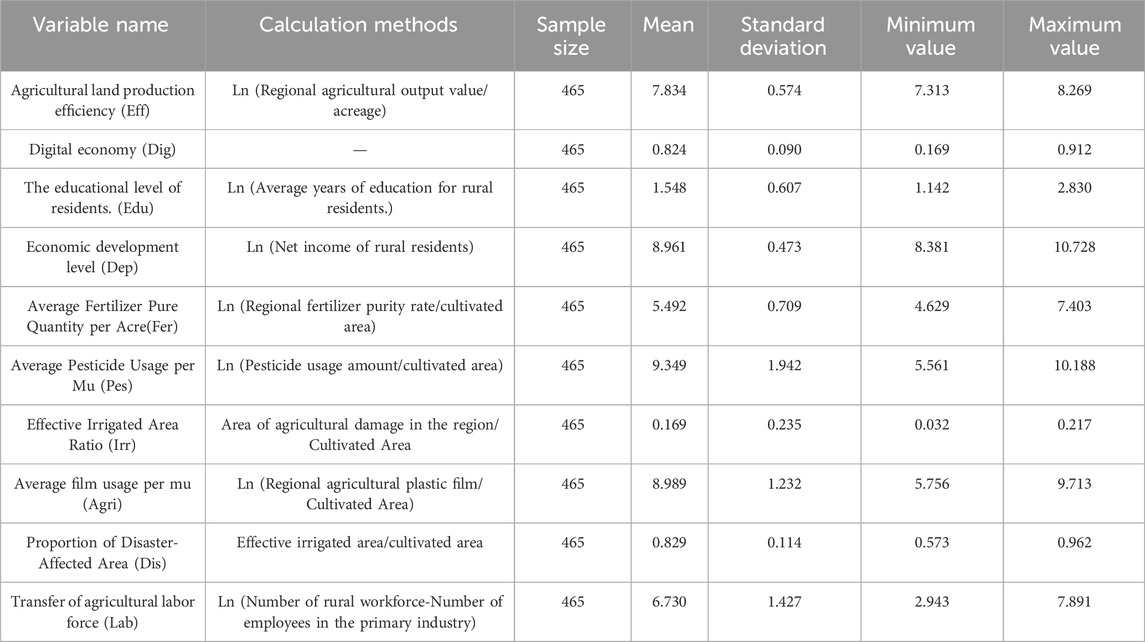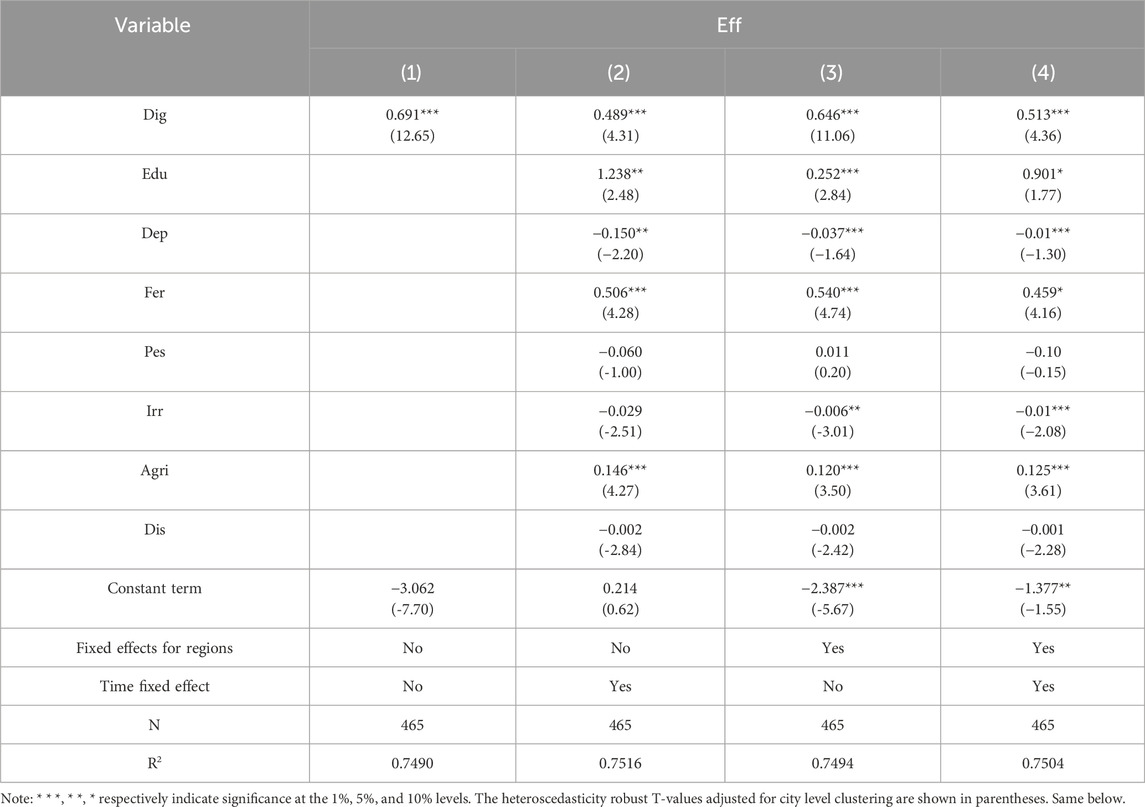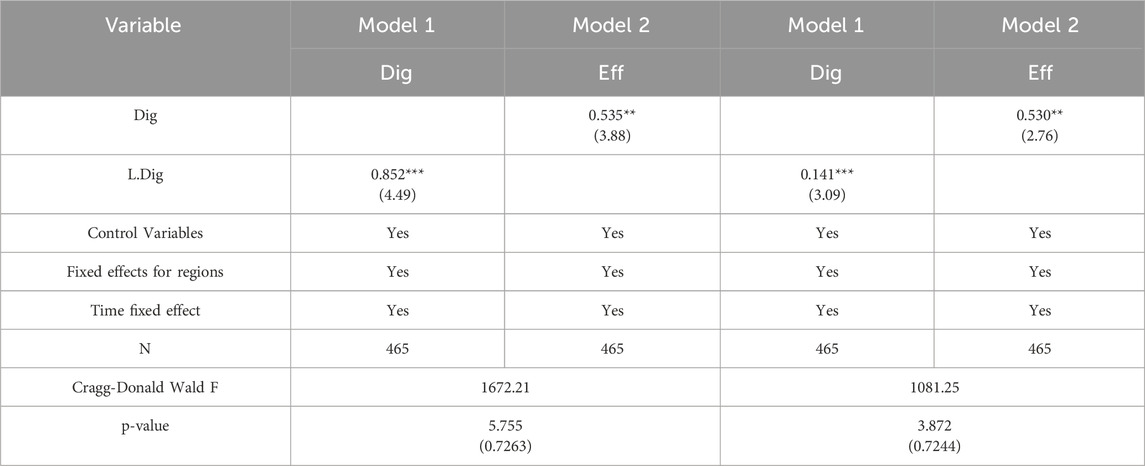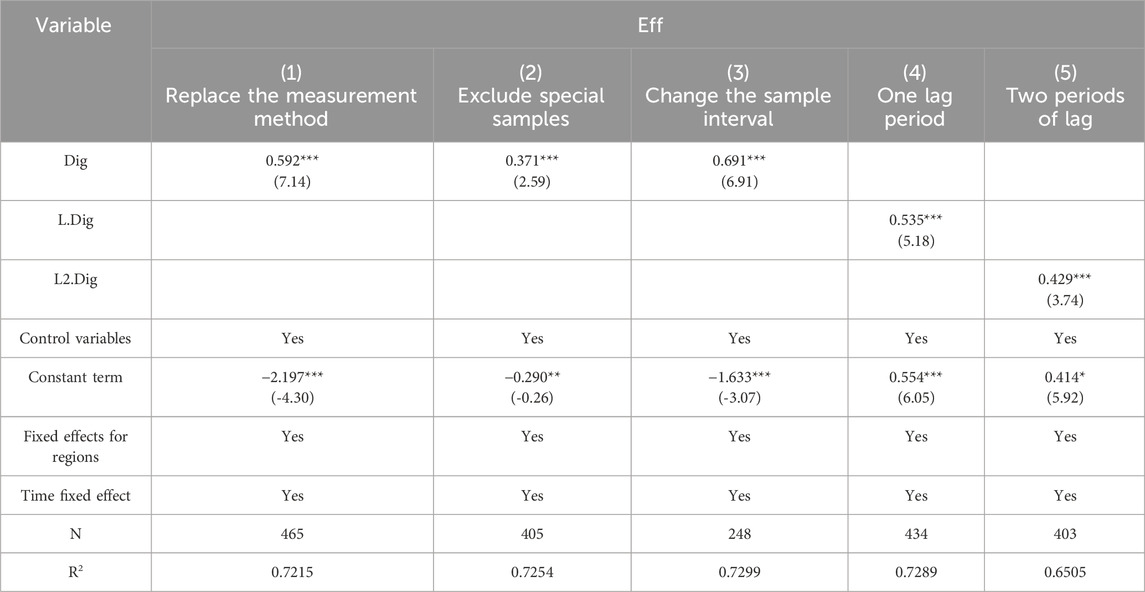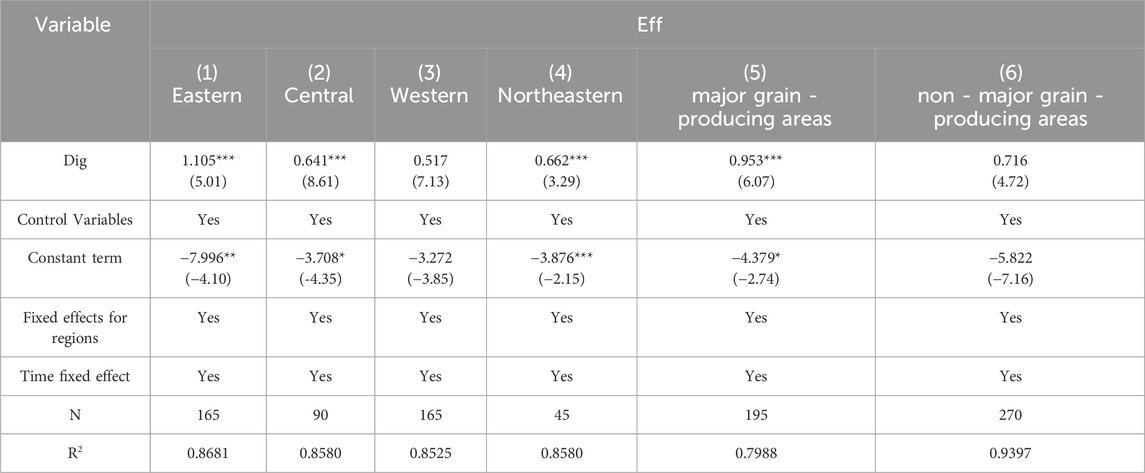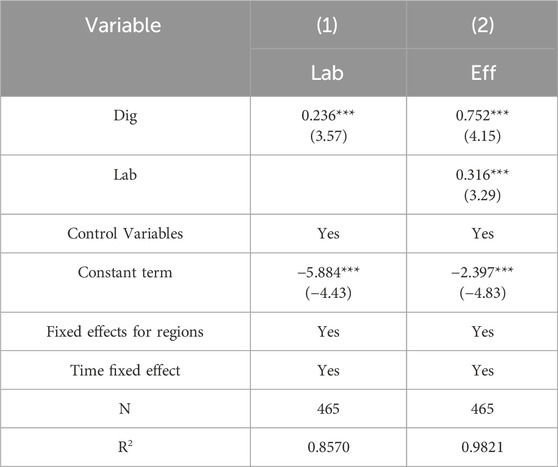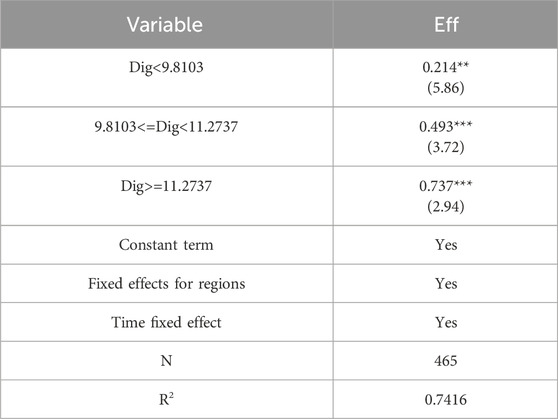- School of Economics, Henan Normal University, Xinxiang, China
The digital economy has emerged as a new driving force and engine for China’s economic growth. However, given the current shortage of production factors, whether the digital economy positively impacts agricultural land productivity remains to be further confirmed. This study employs balanced panel data from 31 Chinese provinces between 2009 and 2023, constructs a three-tier indicator framework, and measures China’s digital economy development level using the entropy method. The research explores the impact and mechanisms of the digital economy on agricultural productivity. Key findings include: (1) Bidirectional fixed-effects models demonstrate that the digital economy significantly enhances agricultural productivity, supported by endogeneity tests, robustness checks, and threshold analysis. (2) Heterogeneity analysis reveals stronger productivity improvements in eastern, central, and northeastern regions, particularly in major grain-producing areas. (3) Mediation tests confirm that the digital economy boosts agricultural productivity by facilitating labor mobility. Based on these conclusions, policy recommendations are proposed: fundamentally improving rural digital infrastructure, establishing region-specific development frameworks, and strengthening support for digital agriculture entities. These measures provide practical pathways to enhance agricultural productivity.
1 Introduction
As of 2024, China’s urbanization rate has reached 67%, an increase of 55.52 percentage points compared with the end of 1949, with an average annual increase of 0.75 percentage points. Since the founding of the People’s Republic of China, remarkable achievements have been made in China’s urbanization construction. The growth of China’s traditional agriculture has mainly relied on factors such as the economies of scale brought about by the innovation of the land system and the demographic dividend brought about by the labor force resources (Lin et al., 2018). The rapid development of urbanization has brought two direct impacts on China’s agricultural production: The reduction in arable land and the outflow of agricultural labor. Therefore, promoting the growth of the agricultural economy requires the exploration of new avenues. The Third Plenary Session of the 20th Central Committee of the Communist Party of China emphasized that “we should improve the system for promoting the in - depth integration of the real economy and the digital economy. We should accelerate the establishment of a system and mechanism to promote the development of the digital economy and improve the policy system to promote the digitalization of industries and the industrialization of digital technology”. This shows the country’s emphasis on the development of the digital economy, which lays a foundation for comprehensively transforming the agricultural development model and realizing the in - depth integration of the digital economy and agriculture. With the rapid development of global digitalization, the digital economy promotes the digital transformation of agriculture by integrating big data, the Internet of Things, blockchain, and 5G communication technologies into agricultural development. It empowers facilities, data, and technology, alters the internal structure of the agricultural industry, triggers the reallocation of production resources, and improves agricultural production efficiency. Thus, the digital economy has pointed out a new direction for agricultural development and has created the possibility of enhancing quality and efficiency in agriculture. As a new engine and driving force for high - quality economic growth, can the digital economy’s role in promoting economic growth be extended to the agricultural industry to improve the production efficiency of agricultural land, and what is the mechanism of this effect? This paper attempts to answer the above questions and provide policy suggestions for further realizing the modernization of agriculture and rural areas.
The concept of “digital economy” was put forward by American economist Tapscott, who believes that the digital economy has ICT infrastructure and various e-commerce models with ICT as the carrier (Tapscott, 1996). As the digital economy spreads around the world, Domestic scholars believe that the digital economy is a series of new - format economic and social activities that take digital information as resources, the Internet platform as the carrier, and digital technology innovation as the driving force (Chen et al., 2022). Its specific characteristics can be divided into three aspects: first, the characteristics of low - cost, standardization, and dynamism; second, the characteristics of low - cost, standardization, and dynamism; third, the characteristics of low - cost, standardization, and dynamism (Xiang and Wu, 2018). To further identify the impact of the digital economy, Many scholars have used the index method, the value - added method, the method of compiling satellite accounts, and methods related to national economic accounting,and the specific subdivision of measurement dimensions are also different. Liu and Meng (2019) divided the digital economy into two parts: the basic industries of the digital economy and the integration effect of the digital economy, and constructed a measurement model of the digital economy by aggregating these two parts. Hong (2019) used the value - added measurement method and the index method to conduct measurements from two dimensions: digital industrialization and industrial digitization. In addition, many studies have shown that the digital economy can make use of the information and intelligent characteristics of the digital economy to transform and upgrade traditional industries, and give birth to new industries, new business forms and new business models, improve production efficiency, and lay a theoretical foundation for improving agricultural land production efficiency.
Agriculture has always been considered as a land-and labor-intensive industry, in which the efficiency of agricultural land production plays a vital role in the overall development of agriculture. At present, the research on agricultural land production efficiency mainly focuses on the measurement and influencing factors of agricultural land production efficiency. From the perspective of input factors, the indicators to measure agricultural land production efficiency can be divided into: agricultural land output efficiency, agricultural labor productivity and total factor productivity, among which agricultural land output efficiency and agricultural labor productivity use the single factor productivity method. In order to further explore how to improve the productivity of agricultural land, many scholars have studied the impact of the current situation of labor force on the productivity of agricultural land and concluded that the transfer of migrant workers, non-agricultural employment and occupational differentiation can significantly improve the productivity of agricultural land (Sun, 2021; Qian and Hong, 2016; Chen, 2020). In addition, some scholars believe that agricultural machinery socialized services have a positive correlation with agricultural land production efficiency by expanding the scale of production (Ling et al., 2022). Since agricultural land can be exchanged and circulated as a commodity, the ownership of agricultural land can also affect the production efficiency of agricultural land. Studies have shown that the confirmation of agricultural land rights can significantly improve the production efficiency of agricultural land after more than 1 year (Gao et al., 2021).
Through the analysis of the existing literature, it can be concluded that: (1) there are abundant literature on the measurement and economic effects of digital economy, and the research on agricultural land production efficiency is still based on the traditional perspective, and there is a certain gap in the existence of digital economy on agricultural land production efficiency. (2) Some studies have shown that labor transfer can improve the productivity of agricultural land, but whether the transfer of agricultural labor force will have the same effect on the productivity of agricultural land remains to be proved. Therefore, this paper constructs an indicator system for the digital economy and conducts measurements from four dimensions: digital fundamental, digital application, digital innovation, and digital transformation. It establishes a bidirectional fixed effects model to examine the impact of the digital economy on agricultural land productivity. Furthermore, it introduces the transfer of agricultural labor as a mediating variable to explore the pathways through which the digital economy affects agricultural land productivity. Finally, by considering the digital economy as a threshold variable, the study examines the threshold effect between the two factors and investigates whether the impact of the digital economy on agricultural land productivity varies across different geographical regions.
2 Theoretical analysis and research hypothesis
2.1 Direct effects
As a new economic form, digital economy can combine data, a new factor of production, with land, labor and other traditional factors of production to be used in agricultural production, realize the digital production mode of agriculture, and then improve the efficiency of agricultural land production. From the perspective of supply side, digital economy integrates digital technologies such as Internet and modern information technology into agricultural production process, implements accurate and efficient operation and management, establishes scientific modern agricultural production system, optimizes the rational allocation of production resources, and improves agricultural output efficiency (Li et al., 2025). At the same time, with the development of digital economy and the emergence of big data, producers can break through the obstacles of information circulation, obtain the information of cutting-edge technology in time, reduce the input cost of technological innovation, solve the problem of farmers to achieve innovation, and then expand the scale of production and improve the overall agricultural land production efficiency (Wen, 2024). From the demand side, the primary application of the digital economy in agriculture is to integrate information technology into agricultural production, thereby achieving a digital transformation in agriculture. This digitalization effectively breaks down the information barriers between consumers and producers, enabling producers to promptly and accurately capture the diverse needs of consumers for customized production. Additionally, based on consumer feedback from the APP, producers can optimize products and then formulate production plans. This approach maximizes the satisfaction of consumer demands, prevents supply and demand imbalances that could lead to overproduction or shortages, and ensures the efficient allocation of limited resources, thus enhancing the efficiency of agricultural land use (Liu, 2020).
Hypothesis 1. The digital economy can improve the production efficiency of agricultural land.
2.2 Indirect effects
2.2.1 The digital economy facilitates the transfer of agricultural labor
The dual economy theory holds that workers engaged in traditional agricultural production tend to pursue more efficient modern industries (Lewis, 1954). Among them, economic factors are also important influencing factors in labor transfer (Jia and Cheng, 2024). On the one hand, the high informatization of the digital economy can effectively reduce the time for laborers to collect job - related information, break the traditional employment information cocoon, provide a wide range of job options, achieve effective reallocation of resources, and promote labor transfer (Li and Gu, 2025). On the other hand, the digital economy attracts modern production factors such as capital, technology, and talent to establish a series of non - agricultural industries, forming new - mode industries with high levels of mechanization and digitization. It extends the industrial chain both vertically and horizontally. The emergence of new industries creates a large number of non - agricultural jobs, which require new employees as human capital support. This increases the labor demand, improves the employment rate of surplus labor, and promotes the transfer of farmers to non - agricultural industries (Tan et al., 2024).
2.2.2 The transfer of agricultural labor promotes the productivity of agricultural land
Based on the new theory of migration economics, labor transfer can increase investment in agricultural mechanization and deepen agricultural capital intensification in the short term. In the long run, it can improve the production efficiency of agricultural land (Woute, 2010). This is mainly because, on the one hand, labor transfer reduces the competitiveness of the agricultural and rural labor force. The elderly, the weak, women, and children gradually become the main body of the rural labor force (Huang and Hu, 2019), which stimulates increased investment in mechanization technology and promotes the substitution effect of agricultural machinery for labor, thereby improving the production efficiency of agricultural land (Wang et al., 2016). On the other hand, labor transfer can significantly increase the income level of families. To maximize the expected family income, family members will re - allocate production factors, causing some production factors to shift to non - agricultural industries. This increases the income of farmers from non - agricultural industries, thereby raising the overall family income level and increasing the possibility of reinvestment in production, so as to improve the production efficiency of agricultural land (Teng and Li, 2020; Wang, 2015).
Hypothesis 2. The digital economy improves the production efficiency of agricultural land by promoting the transfer of agricultural labor.
The specific theoretical mechanism diagram can be seen in Figure 1.
3 Research design
3.1 Data source
Based on the availability and scientific nature of the data, this paper selects panel data from 31 provinces in China from 2009 to 2023 for empirical analysis. The main data come from the annual “China Statistical Yearbook”, “China Agricultural Statistical Yearbook”, and “China Population and Employment Statistical Yearbook” published by the National Bureau of Statistics. Considering price fluctuations, this paper deflates the output value of each year using the constant price index of 2009. For some missing values, linear interpolation is used in this paper.
3.2 Description of the variable
3.2.1 Dependent variable: agricultural land production efficiency (Eff)
In the existing literature, there are mainly two proxy variables for land production efficiency: yield per mu and profit per mu. The difference between the two is that the vector of input factors is no longer included in the profit per mu model (Wang, 2015). Based on the research purpose of this paper, considering that it is difficult to standardize the yields of different crops, the output value per mu is selected as the proxy variable for agricultural land production efficiency. The output value per mu of regional agricultural land is calculated by dividing the total regional agricultural output value by the sown area. Since the multiple cropping index of land varies across different regions, this paper uses the sown area instead of the cultivated land area.
3.2.2 Explanatory variable: digital economy (Dig)
The development of the digital economy relies on the theory of “four requirements”: digital foundation, digital application, digital innovation, and digital industry. Referring to the approach of Jiao and Sun (2021), based on the availability, comparability, and comprehensiveness of data and in combination with the above-mentioned “four requirements” theory, this paper constructs the indicator system shown in Table 1 below and uses the entropy method to measure the development level of the digital economy.
3.2.3 Control variables
To control the potential impact of the existence of other factors on the production efficiency of agricultural land, this paper draws on the methods of Li et al. (2025) and Li and Bai (2018) to select the education level of residents (Edu), the level of economic growth (Dep), the average amount of pure - converted chemical fertilizers per mu (Fer), the average amount of pesticide used per mu (Pes), the proportion of effectively irrigated area (Irr), the average amount of agricultural film used per mu (Agri), and the proportion of disaster - affected area (Dis). Theoretically, in the process of agricultural production, these intermediate - input capital goods will improve the production efficiency of agricultural land. That is, the effects of the first six indicators are positive, while the proportion of disaster - affected area has a negative impact on agricultural production, and its effect is significantly negative. Of course, this needs to be verified later in the paper.
3.2.4 Mediator variable: transfer of agricultural labor force (Lab)
Through the above analysis of the theoretical mechanism, labor transfer can reduce agricultural competitiveness, improve the level of agricultural production mechanization, and thus enhance the production efficiency of agricultural land. This paper selects the level of labor transfer as an intermediary variable. Drawing on the research method of Wu (2016), it is measured by subtracting the number of employees in the primary industry from the number of rural employees.
The specific calculation methods and descriptive statistics for all variables used in this article can be found in Table 2.
3.3 Model setting
Based on the aforementioned theoretical analysis, to verify the impact of the level of digital economy development on agricultural land production efficiency, the following benchmark regression model is constructed:
(1) In the formula,
To further examine the impact mechanism of the development level of the digital economy on agricultural land production efficiency, this paper draws on the approach of Baron and Kenny (1986) to construct the following mediating effect model:
Among them,
4 Empirical analysis
4.1 Benchmark regression results
This paper uses stata software to conduct a preliminary test of the benchmark Model (1). The regression results in columns (1)(2)(3)(4) of Table 3 all take the development level of the digital economy as the explanatory variable, and study its impact on the production efficiency of agricultural land by gradually adding control variables, regional fixed effects, and year fixed effects. Thus, Hypothesis H1 is verified. Column (1) of Table 3 shows that without adding control variables and without fixing effects such as regions and time, the coefficient of the digital economy is significantly positive at the 1% level. The results in columns (2) and (3) of Table 3 show that after adding control variables and fixing time and regions respectively, the coefficient of the digital economy is still significantly positive at the 1% level. The result in column (4) of Table 3 shows that after adding control variables and fixing regional and time effects, the coefficient of the digital economy is 0.513, and it passes the significance test at the 1% level. It can be seen that the digital economy can significantly improve the production efficiency of agricultural land, and Hypothesis 1 is verified. Among the control variables, we further observe that the per-mu pure amount of chemical fertilizers and the per-mu usage of plastic films are significantly positive, which indicates that the development of biotechnology represented by chemical fertilizers and plastic films can significantly improve the production efficiency of agricultural land. However, the logarithm of the per-mu usage of pesticides is negative but not significant. Nevertheless, it also shows that pesticides are not beneficial to the production efficiency of agricultural land in China, which is basically consistent with Lin (2011) research results. Finally, it is found that the disaster rate is not significant for agricultural land production, indicating that the disaster rate has little impact on the production efficiency of agricultural land, which shows that China’s agriculture has strong disaster resistance.
4.2 Endogeneity test
Based on the above analysis, it can be concluded that the digital economy can significantly improve the efficiency of agricultural land production. However, the improvement of agricultural land production efficiency may also further promote the development of the digital economy. To eliminate this two-way causal relationship, this paper draws on the research of Li et al. (2024) and Wen (2023), and selects the interaction term between the one-period lagged term of the digital economy development level and the number of post and telecommunications offices per million people in each province in 1984 as the two instrumental variables in this paper. The reason is that the local communication level is related to the historical data of post and telecommunications offices. The number of post and telecommunications offices determines the current number of fixed-line telephones and Internet interfaces, which in turn affects the current local digital economy level, meeting the relevance condition of instrumental variables. Moreover, as a traditional communication facility, post and telecommunications offices have gradually faded out of people’s lives, so they will not have an impact on the efficiency of agricultural land production, which also meets the exclusivity of instrumental variables.
This paper uses the two-stage least squares method to conduct an endogeneity test. To test the validity of the instrumental variables, Table 4 reports a series of test results for the instrumental variables. First, the estimated values and t-values of the two instrumental variables in the first-stage regression are reported. The regression coefficients of the two instrumental variables are significantly positive at the 1% level, indicating that the two instrumental variables used in this paper are significantly and positively correlated with the development level of the digital economy. In particular, the coefficient of the one-period lag of the digital economy level exceeds 0.8, indicating that this indicator has a very large impact on the current development level of the digital economy. The Cragg - Donald Wald F values obtained from the weak instrumental variable test are relatively large, which indicates that there is no problem of weak instrumental variables. The p-value of the over-identification test result is very large, indicating that we cannot reject the hypothesis that the two instrumental variables are exogenous. All these test indicators show that the two instrumental variables selected in this paper are appropriate.
In addition, according to the regression results in Table 4, after adopting the two-stage least squares instrumental variable regression, the coefficients of the digital economy level are all significantly positive at the 5% level, which further verifies the conclusion of the above benchmark regression in this paper. Therefore, it has passed the endogeneity test.
4.3 Robustness tests
4.3.1 Replace the measurement method
Considering that using different measurement methods may lead to certain deviations in the results, this paper uses the principal component analysis method to re - measure the digital economy level and uses it as a new explanatory variable. By adding control variables and fixing provinces and time, the above - mentioned model is used to conduct the benchmark regression again. The regression results are shown in column (1) of Table 5. The coefficient of the digital economy level is significantly positive at the 1% level, indicating that the digital economy growth level measured by the principal component analysis method instead of the entropy method still has a promoting effect on the agricultural land production efficiency. Therefore, the reliability of the benchmark regression results is verified.
4.3.2 Exclude special samples
The research sample in this paper consists of panel data from 31 provinces across the country, including four municipalities directly under the Central Government, namely Beijing, Tianjin, Shanghai, and Chongqing. Since municipalities directly under the Central Government in China are provincial-level administrative regions under the jurisdiction of the central government and have special political, economic, and cultural statuses, they have absolute advantages compared with other provinces, which may affect the results of this paper. Therefore, after excluding the sample data of these four municipalities directly under the Central Government, the model set in this paper is used for regression again, and the results are shown in Table 5 (2) below. The results in Column (2) of the TABLE show that the coefficient of the digital economy is 0.371 at the 1% significance level, which is consistent with the results of the benchmark regression, indicating that it has passed the robustness test.
4.3.3 Change the sample interval
The sample time interval selected in this paper is from 2009 to 2023, with a relatively large time span. Moreover, the digital economy was first proposed in China at the G20 Summit in 2016. Studying the impact of the digital economy on agricultural land production efficiency after 2016 is more referential. Therefore, this paper shortens the sample time interval to 2016–2023 and conducts regression again. The results are shown in column (3) of Table 5. The coefficient of the digital economy is still significantly positive, passing the robustness test. Compared with the benchmark regression results, the coefficient of the digital economy has increased significantly, indicating that the digital economy has a greater role in improving agricultural land production efficiency in the recent period.
4.3.4 Consider the lag effect
The digital economy’s impact on enhancing agricultural land productivity involves multiple stages and exhibits a certain degree of time lag. To investigate whether this impact is delayed, this study re-estimates the regression by using the digital economy’s development level lagged by one period and two periods as new dependent variables, with the results presented in Table 5 (4) and (5). The findings indicate that the digital economy’s effect on improving agricultural land productivity is significant both when lagged by one period and two periods, confirming the delayed nature of its impact.
4.4 Heterogeneity analysis
4.4.1 Analysis of heterogeneity in different regions
There are differences in the levels of economic growth, resource endowments, institutional environments, etc. among different regions. This paper draws on the practice of Zhang and Yang (2023), and divides the sample regions into four categories: eastern, central, western and northeastern regions according to the classification standards of the National Bureau of Statistics, and conducts regression separately. The results are shown in Table 6 (1) (2) (3) (4). According to the results, the coefficients of the digital economy in the eastern, central, and northeastern regions are positively significant, indicating that the digital economy can effectively improve the agricultural land production efficiency in the eastern, central, and northeastern regions. The possible reason is that the eastern, central and northeastern regions have certain advantages in resource endowment compared with the western regions, and the high level of digital economy development can effectively combine with local sufficient agricultural land and labor force and other factors of production to improve the efficiency of agricultural land production. The reason why it is not significant in the western region lies in the lack of production resources due to remote geographical location and harsh climate environment, and it is easy to be affected by extreme weather in the production process, which hinders the improvement of agricultural land production efficiency.
4.4.2 Distinguish whether it is a principal grain producing area
Agricultural land is the fundamental resource for human survival and development. The quantity and quality of agricultural land are the foundation for enhancing agricultural production capacity and ensuring food security. The development of the digital economy has improved the production efficiency of agricultural land and may play a certain role in promoting the increase of grain output. This paper divides the sample into grain producing areas and non-grain producing areas by referring to Zhou et al. (2023).1 As can be seen from columns (5) and (6) of Table 6, the coefficient of the digital economy in major grain - producing areas is significantly positive at the 1% level, while the coefficient of the digital economy in non - major grain - producing areas is not significant. This indicates that the digital economy has a more significant promoting effect on the production efficiency of agricultural land in major grain - producing areas. The possible reason is that the mechanization level in major grain - producing areas is relatively low. The development of the digital economy has invigorated the region, activating redundant local labor and production resources, optimizing the efficient allocation of these resources, and thus enhancing agricultural land productivity. For regions not primarily focused on food production, the scarcity of land resources is the most critical issue. Even with a high level of digital economy, this does not contribute to improving agricultural land productivity.
4.5 Mechanism verification
The above regression results and robustness tests have verified that the digital economy significantly improves the production efficiency of agricultural land. But what is its mechanism of action? According to the theoretical analysis above, labor transfer is selected as the mediating variable, and regression is carried out using the mediation test Models 2, 3 constructed in this paper. The test results of the mediating effect of labor transfer are shown in Table 7. Through the analysis of the results, it can be seen that the digital economy can significantly promote labor transfer, and labor transfer can significantly improve the production efficiency of agricultural land, indicating that labor transfer can significantly play a mediating effect, thus verifying the validity of Hypothesis 2.
4.6 Threshold effect testing
In this paper, the Bootstrap method is used to conduct a threshold existence test with 500 self - samplings. The results are shown in Table 8. The results show that the model with the digital economy as the threshold variable has passed the single - threshold and double - threshold tests. From the estimation results in Table 9, it can be seen that the estimated coefficients of the digital economy within the three confidence intervals are all significantly positive at the 1% level and gradually increasing. Therefore, there is an increasing threshold effect.
5 Conclusions and policy recommendations
5.1 Conclusion
This paper uses the balanced panel data of 31 provinces from 2009 to 2023 and adopts the two-way fixed effects model to analyze the impact of the digital economy on the production efficiency of agricultural land. The main conclusions are divided into the following aspects: First, the digital economy significantly boosts agricultural land productivity. After the endogeneity test and robustness test, the results remain robust. Second, the digital economy’s impact on agricultural land productivity varies significantly. It notably enhances productivity in the eastern, central, and northeastern regions, as well as in major grain-producing areas. However, in western regions and non-grain-producing areas, the digital economy does not significantly improve agricultural land productivity. Third, mechanism analysis indicates that facilitating labor mobility is a key pathway for the digital economy to enhance agricultural land productivity.
5.2 Suggestion
Based on the research results of this paper, the following policy suggestions are put forward:
Firstly, To improve the digital infrastructure in rural areas, the digital economy needs a solid foundation of digital infrastructure to enhance agricultural productivity. This infrastructure ensures that digital technologies and resources are effectively integrated into the production process. Therefore, the government should increase investment in 5G networks, big data, and smart terminals, establish agricultural smart demonstration parks, provide policy subsidies and tax reductions for companies undergoing digital transformation, encourage individuals with digital expertise to contribute to agricultural digitalization, and offer free digital skills training to farmers, thereby enhancing the digital service level that aligns with the agricultural industry.
Secondly, construction systems should be formulated according to local conditions in different regions, and precise policies should be implemented. For the western region, the digital agriculture development guarantee system should be fundamentally improved first, good digital agriculture business entities should be introduced and cultivated, infrastructure construction should be improved, and the local digital development level should be enhanced. Then, the ways to improve the efficiency of agricultural land production can be broadened. For the eastern, central, and northeastern regions, platforms for the integration of the digital economy and agricultural production should be further constructed. Local available digital resources should be integrated to achieve in - depth integration of digital technology and agriculture. Starting from the real economy, a new batch of new business models and new business forms should be spawned relying on the digital economy to consolidate and strengthen digital development.
Thirdly, the cultivation of the digital agriculture business group should be strengthened. Digital skills training should be incorporated into the core content of the high - quality farmer cultivation project and the training of leaders of rural practical talents. Practical training such as Internet of Things operation, data analysis, e − commerce operation, and the use of intelligent management platforms should be carried out for family farm owners, cooperative leaders, and agricultural enterprise managers to improve the human capital level of those participating in the development of digital agriculture.
Data availability statement
The original contributions presented in the study are included in the article/supplementary material, further inquiries can be directed to the corresponding author.
Author contributions
LL: Conceptualization, Data curation, Formal Analysis, Funding acquisition, Investigation, Methodology, Project administration, Resources, Software, Supervision, Validation, Visualization, Writing – original draft, Writing – review and editing. MQ: Conceptualization, Data curation, Formal Analysis, Funding acquisition, Investigation, Methodology, Project administration, Resources, Software, Supervision, Validation, Visualization, Writing – original draft, Writing – review and editing.
Funding
The author(s) declare that financial support was received for the research and/or publication of this article.This research paper is derived from the Henan Province Philosophy and Social Science Planning Project, with the project number: 2024BJJ201.
Conflict of interest
The authors declare that the research was conducted in the absence of any commercial or financial relationships that could be construed as a potential conflict of interest.
Generative AI statement
The author(s) declare that no Generative AI was used in the creation of this manuscript.
Publisher’s note
All claims expressed in this article are solely those of the authors and do not necessarily represent those of their affiliated organizations, or those of the publisher, the editors and the reviewers. Any product that may be evaluated in this article, or claim that may be made by its manufacturer, is not guaranteed or endorsed by the publisher.
Footnotes
1Regarding the definition of major grain-producing areas, major grain-marketing areas, and areas with balanced grain production and marketing, this article adopts the classification method in the “Opinions on Further Deepening the Reform of the Grain Circulation System” issued by the State Council in 2001: Major grain-producing areas refer to 13 provinces (autonomous regions), namely Liaoning, Jilin, Heilongjiang, Inner Mongolia, Hebei, Shandong, Anhui, Jiangsu, Jiangxi, Henan, Hunan, Sichuan, and Hubei.
References
Baron, R. M., and Kenny, D. A. (1986). The moderator-mediator variable distinction in social psychological research: conceptual,strategic,and statistical considerations. J. Personality Soc. Psychol. 51 (6), 1173–1182. doi:10.1037/0022-3514.51.6.1173
Chen, X. H., Li, Y. Y., Song, L. L., and Wang, Y. J. (2022). Theoretical system and research prospect of the digital economy. J. Manag. World 38 (2), 208-224+13–16. doi:10.19744/j.cnki.11-1235/f.2022.0020
Chen, Z. W. (2020). HEN Z w.Professional differentiation of farmers, operation scale and agricultural land production efficiency -Verification based on county data. J. Hebei Univ. Econ. Bus. 41 (4), 72–79. doi:10.14178/j.cnki.issn1007-2101.20200525.001
Gao, X. W., Fang, S. L., Shi, X. J., and Wei, L. B. (2021). Stability of agricultural land property rights and agricultural land productivity-based on a new round of research on agricultural land confirmation. Chin. Rural. Econ. 10, 24–43. doi:10.20077/j.cnki.11-1262/f.2021.10.002
Huang, S. H., and Hu, X. P. (2019). The impact of cultivated land quality on grain production under the requisition-compensation balance system. Finance and Econ. 12, 121–129.
Jia, X. J., and Cheng, M. W. (2024). Inter - provincial transfer of rural labor force in China (1978 - 2021): quantity estimation and spatial - temporal characteristics. Chin. Rural. Econ. 6, 72–93. doi:10.20077/j.cnki.11-1262/f.2024.06.004
Jiao, S. T., and Sun, Q. B. (2021). Research on the impact of China's digital economy development on industrial structure upgrading. J. Industrial Technol. Econ. 40 (5), 146–154.
Lewis, W. (1954). Economic development with unlimited supplies of labour. Manch. Sch. 22 (2), 139–191. doi:10.1111/j.1467-9957.1954.tb00021.x
Li, J., Yang, S. Q., Luo, Z. Y., and Qi, Y. B. (2025). Research on the impact of digital economy development in Sichuan Province on agricultural land use Efficiency. Chin. J. Agric. Resour. Regional Plan. Available online at: http://kns.cnki.net/kcms/detail/11.3513.s.20250328.1503.012.html.
Li, K., and Gu, M. J. (2025). Digital economy, labor transfer, and new quality productive forces. Mod. Manag. Sci. 2, 190–200.
Li, L. Y., and Bai, Y. X. (2018). Human-land ratio, mechanization level and agricultural land productivity. Macroeconomics 9, 147–158. doi:10.16304/j.cnki.11-3952/f.2018.09.013
Li, Y., Zhao, T. T., Shu, T. Y., and Wei, Y. X. (2024). Impact of development level of digital economy on agricultural production efficiency under carbon emission constraint. Chin. J. Eco-Agriculture 32 (11), 1829–1842. doi:10.12357/cjea.20240443
Lin, M. Y. (2011). The impact of labor transfer on regional agricultural land use efficiency: an econometric analysis based on provincial panel data. China Land Sci. 1, 62–69. doi:10.13708/j.cnki.cn11-2640.2011.01.011
Lin, W. S., Wang, Z. G., and Wang, M. Y. (2018). Farmland ownership, factor allocation and agricultural production efficiency: an empirical analysis based on a survey of labor dynamics in China. Chin. Rural. Econ. 8, 64–82. doi:10.20077/j.cnki.11-1262/f.2018.08.005
Ling, W. J., Su, X. M., Ma, Y., Li, S. M., and Zeng, D. P. (2022). The influence of agricultural machinery socialization service on China's agricultural land production efficiency-An empirical study based on three-stage DEA and tobit model. J. Chin. Agric. Mech. 43 (11), 239–248. doi:10.13733/j.jcam.issn.2095-5553.2022.11.033
Liu, F., and Meng, Q. (2019). MENG q.Digital economy development: measurement, international comparison and policy recommendations. Qinghai Soc. Sci. 4, 83–90. doi:10.14154/j.cnki.qss.2019.04.013
Liu, Y. S. (2020). Effectiveness analysis and coping strategies of agricultural digital transformation. Econ. Rev. J. 7, 106–113. doi:10.16528/j.cnki.22-1054/f.202007106
Qian, L., and Hong, M. Y. (2016). Non-agricultural employment, land transfer and changes in agricultural production efficiency-An empirical analysis based on CFPS. Chin. RuraEconomy 12, 2–16. doi:10.20077/j.cnki.11-1262/f.2016.12.001
Sun, X. T. (2021). Promotion or inhibition? study on the impact of non-agricultural employment on agricultural land efficiency. Res. Econ. Manag. 42 (1), 133–144. doi:10.13502/j.cnki.issn1000-7636.2021.01.009
Tan, C. H., Pei, X. K., Yu, S. M., and Huang, Z. W. (2024). How does the digital economy promote the improvement of agricultural mechanization level? from the perspective of labor transfer. J. China Agric. Univ. 29 (4), 54–66.
Tapscott, D. (1996). The digital economy: promise and peril in the age of networked intelligence. New York: McGraw-Hill.
Teng, Z. Y., and Li, H. (2020). Transportation costs and agricultural mechanization. Econ. Rev. 1, 84–95. doi:10.19361/j.er.2020.01.06
Wang, J. Y. (2015). Re-examination of the relationship between land productivity and farm household management scale during the transformation period. J. Manag. World 9, 65–81. doi:10.19744/j.cnki.11-1235/f.2015.09.006
Wang, O., Tang, K., and Zheng, H. M. (2016). The impact of agricultural machinery on the labor substitution intensity and grain output. Chin. Rural. Econ. 12, 46–59. doi:10.20077/j.cnki.11-1262/f.2016.12.004
Wang, Z. C. (2015). Does the outflow of rural labor reduce agricultural efficiency? Stat. Res. 3, 54–61. doi:10.19343/j.cnki.11-1302/c.2015.03.007
Wen, F. A. (2023). Digital economy development, factor allocation efficiency, and urban green production efficiency. Industrial Econ. Res. 3, 57–71+86. doi:10.13269/j.cnKi.ier.2023.03.002
Wen, F. A. (2024). Paths for the digital economy to empower the construction of a strong agricultural country. J. Jishou Univ. Sci. 45 (2), 1–9. doi:10.13438/j.cnki.jdxb.2024.02.010
Woute, R. S. E. F. (2010). Migration and technical efficiency in cereal production: evidence from Burkina Faso. Agric. Econ. 41 (5), 385–395. doi:10.1111/j.1574-0862.2010.00452.x
Wu, S. L. (2016). The contribution of agricultural labor mobility to China's economic growth. Econ. Res. J. 2, 97–110.
Xiang, S. J., and Wu, W. J. (2018). Latest developments and implications of OECD's research on digital economy accounting. Stat. Res. 35 (12), 3–15. doi:10.19343/j.cnki.11-1302/c.2018.12.001
Zhang, X. X., and Yang, X. J. (2023). The influence of digital economy on farmers' land transfer behavior. Smart Agric. Guide 3 (21), 112–115. doi:10.20028/j.zhnydk.2023.21.027
Keywords: digital economy, agricultural labor transfer, agricultural land production efficiency, two-way fixed effects, threshold effect testing
Citation: Li L and Qu M (2025) Digital economy, transfer of agricultural labor force and agricultural land production efficiency. Front. Environ. Sci. 13:1652016. doi: 10.3389/fenvs.2025.1652016
Received: 24 June 2025; Accepted: 14 July 2025;
Published: 23 July 2025.
Edited by:
Shikuan Zhao, Chongqing University, ChinaReviewed by:
Wu Haoqiang, Wuhan Polytechnic University, ChinaChaozheng Zhang, Hunan Agricultural University, China
Changming Wang, Northwest University, China
Copyright © 2025 Li and Qu. This is an open-access article distributed under the terms of the Creative Commons Attribution License (CC BY). The use, distribution or reproduction in other forums is permitted, provided the original author(s) and the copyright owner(s) are credited and that the original publication in this journal is cited, in accordance with accepted academic practice. No use, distribution or reproduction is permitted which does not comply with these terms.
*Correspondence: Manman Qu, MTk3MTI1NzE3MjdAMTYzLmNvbQ==
 Liuyan Li
Liuyan Li Manman Qu
Manman Qu